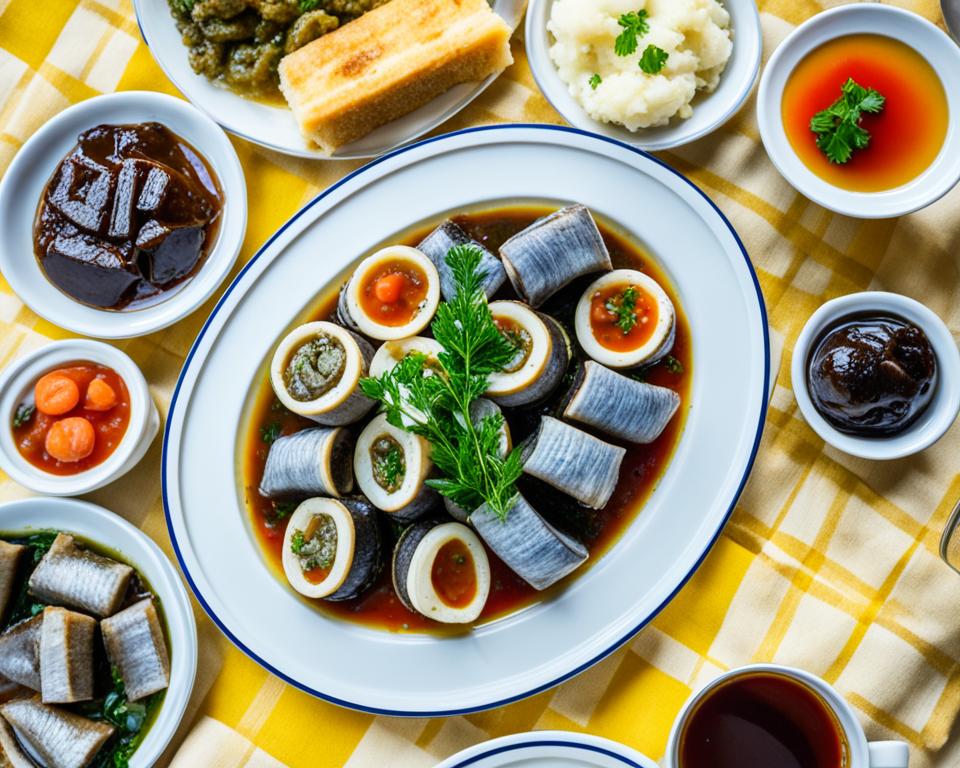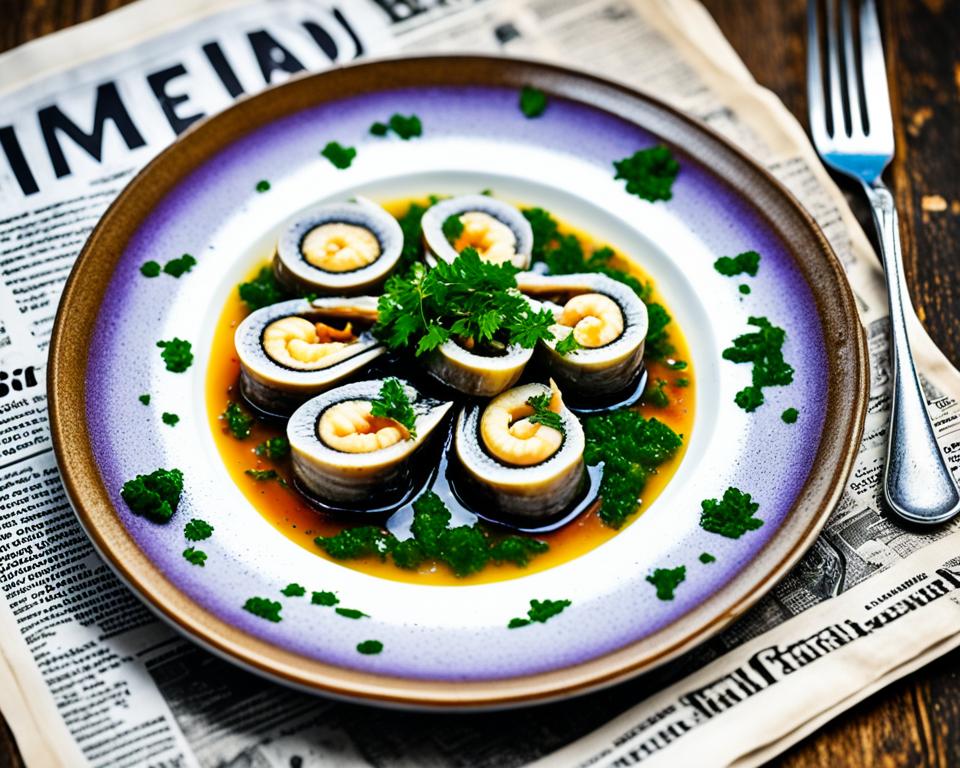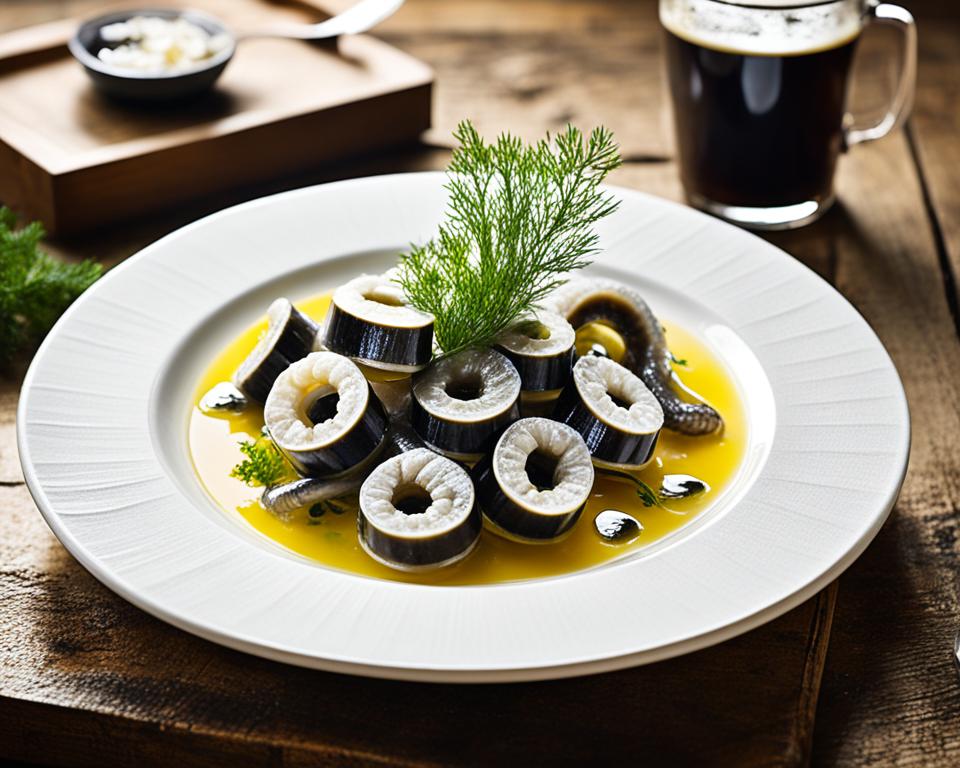Jellied eels are a key part of British food history, especially in the East End of London. This dish is made from fresh eels in a savory gelatin broth. It has been a favorite for centuries, showing the unique tastes and traditions of the area.
From its simple beginnings to being a famous British dish, jellied eels tell the story of the UK’s rich food culture.
Read interesting things at : kamilyle
Key Takeaways
- Jellied eels are a traditional British dish, particularly associated with London’s East End.
- The dish is made from fresh eels that are cooked in a savory gelatin broth.
- Jellied eels have been a beloved local specialty for centuries, reflecting the rich food culture of the region.
- The dish has become an iconic representation of British culinary heritage.
- Exploring the history, preparation, and cultural significance of jellied eels provides insight into the diverse and unique flavors of British cuisine.
Jellied Eels: An Introduction
Jellied eels are a classic eel delicacy in London’s East End. They are made by simmering fresh eels in a broth that turns into a firm jelly. This dish has been loved for generations, making it a key part of traditional British food and east end cuisine.
Making jellied eels is a detailed process. The eels are cleaned, seasoned, and cooked just right. As the broth cools, it turns into a savory gelatin that wraps around the eel flesh. This mix of flavors and textures is unique and has won over many fans in the East End.
“Jellied eels are a quintessential part of East End culture, a tangible link to the area’s rich history and traditions.”
Some people love jellied eels, while others might find them hard to get used to. Yet, their unique taste and texture keep drawing people in. They are a must-try for anyone wanting to explore London’s East End food scene.
The History of Jellied Eels
The story of traditional British food, jellied eels, starts in London’s East End cuisine. Eel fishing was big in the River Thames. This led to many eel dishes, like the famous jellied eels.
This savory gelatin dish became a big part of the East End’s culture. It’s now a key part of London street food. Making jellied eels became a family tradition, with each family having their own way of doing it.
Origins in London’s East End
Jellied eels have a long history in London’s East End. This area was known for its lively markets and diverse people. It was the heart of the eel trade.
Eel fishermen worked hard along the River Thames. They brought their catch to sell and cook in local kitchens and street stalls.
- The River Thames was full of eels, making them cheap and easy to get for East End folks.
- Eel dishes, like jellied eels, became a big part of the culinary heritage there.
- Over time, making jellied eels became an art, with each family or vendor adding their own twist.
Jellied eels are a symbol of the East End’s strength and pride in their London street food. They show the lasting impact of this area’s culinary heritage. The dish is still celebrated today as a reminder of the East End’s rich history.
Preparing Jellied Eels
The making of jellied eels is a special tradition in British cuisine. It’s all about turning fresh, top-quality eels into a unique dish. This process has been perfected over many years.
Ingredients and Cooking Process
First, you need to pick fresh, eco-friendly eels. Then, clean and fillet them. Next, simmer them in a tasty broth until they release their savory gelatin.
This gelatin is what makes the dish special. It sets as it cools, turning into the meat jelly everyone loves.
Cooking jellied eels needs patience and skill. You simmer the eels for a long time to get the gelatin right. After, pour the gelatin-rich broth into molds to cool and set. This turns it into the famous jellied eels.
| Ingredient | Quantity |
|---|---|
| Fresh eels | 1 kg |
| Water | 2 liters |
| Vinegar | 1/4 cup |
| Salt | 1 tsp |
| Black pepper | 1/2 tsp |
The end result is a true British culinary treasure. It shows the hard work and love put into making this dish over the years.
Jellied Eels: The Iconic British Dish
Jellied eels are a beloved British dish from London’s East End. They symbolize the area’s culinary traditions. These savory gelatinous eels have won the hearts of many Londoners over the years. They are now seen as a key part of the city’s culinary heritage.
These traditional British foods date back to the late 19th century. Back then, the River Thames was full of eels, which were a cheap and reliable food source for the East End workers. The idea of boiling and cooling the eels in a gelatin broth came from this time. This created the famous jellied eel dish.
- The taste of jellied eels comes from a mix of the eel’s rich texture and the jelly-like broth.
- Recipes often use spices like allspice and black pepper to highlight the eel’s sweetness.
- These eels are served cold, often with malt vinegar for a tangy touch.
Jellied eels have a strong place in the East End community’s culinary heritage. Famous vendors and stalls are known for their jellied eels. They keep the tradition alive by sharing their recipes and methods over the years. These iconic British spots are key in keeping jellied eels a valued part of local cuisine.
“Jellied eels are a true taste of London’s East End – a humble but delicious dish that has been part of the fabric of the community for generations.”
The iconic British dish is still loved today, showing the strong bond between East End people and their culinary heritage. Jellied eels are a favorite, showing the community’s resourcefulness and love for the River Thames.
Savory Gelatin: A Unique Culinary Experience
Jellied eels are a key British dish known for their jelly-like texture. This savory gelatin makes them stand out from other seafood. It comes from the eel meat’s natural collagen, which makes the dish firm yet delicate.
This savory gelatin connects us to London’s East End, where it’s been loved for years. Making meat jelly from eel shows British cooks’ creativity and resourcefulness. They use the eel’s natural properties to create a unique taste experience.
“The jelly-like texture of jellied eels is unlike anything else in the world of seafood. It’s a truly distinctive mouthfeel that sets this traditional British food apart.”
Jellied eels can be eaten hot or cold. The savory gelatin contrasts well with the tender eel meat. This makes the dish both comforting and intriguing. It invites diners to enjoy the rich history and flavors of this iconic eel delicacy.
Traditional British Street Food
London’s East End is famous for its street food culture. Jellied eels are a key part of this scene. They have been loved by locals and visitors for years. These vendors keep the East End’s iconic British cuisine alive.
Iconic Vendors and Stalls
In places like Petticoat Lane and Whitechapel, jellied eels are a common find. These street food spots are more than just places to eat. They are where people meet, share stories, and enjoy a true taste of London.
| Iconic Vendor | Location | Specialty |
|---|---|---|
| F. Cooke | Hoxton Market | Traditional Jellied Eels |
| Tubby Isaac’s | Whitechapel | Jellied Eels and Pie and Mash |
| M. Manze | Peckham | Jellied Eels and Liquor |
These vendors are the heart of East End cuisine. They offer a peek into the area’s rich street food culture. This culture has shaped the identity of this historic London area.
“Jellied eels are not just a dish, they’re a way of life in the East End. These stalls are the heartbeat of our community, serving up a taste of tradition that has endured for generations.”
Eel Delicacy: A Culinary Heritage
Jellied eels show the deep culinary roots of London’s East End. They highlight the creativity and resourcefulness of the locals. This dish has been loved for many years, keeping alive the tastes and methods of the area.
The story of jellied eels goes back to the late 1800s. Back then, the East End’s waterways were full of freshwater eels. These eels were a cheap and nutritious food, leading to new recipes and ways of cooking. Cooks in the East End used the gelatin in eel bones to make a savory aspic. This created the famous jellied eel dish.
Now, jellied eels are still loved in the East End’s markets and eel shops. These places are important to the local food scene. They attract both locals and visitors who want to try this special eel delicacy. This shows how much jellied eels mean to the East End’s food culture.
“Jellied eels are more than just a dish – they’re a window into the history and identity of London’s East End. Each bite carries the stories and traditions of generations of local cooks and purveyors.”
The East End is changing, but jellied eels show the lasting impact of traditional British food. This dish keeps the East End’s culinary heritage alive. It will continue to be celebrated and shared for years to come.
The Jellied Eels Revival
In recent years, there’s been a big interest in traditional British food. People are now loving the culinary heritage of jellied eels. This has led to more vendors and restaurants offering this British dish. Food lovers are eager to learn about and celebrate this East End delicacy.
The Jellied Eels Revival shows how much people love this unique dish. In London, new chefs and entrepreneurs are bringing back the flavors and traditions of jellied eels. They’re making this traditional British food experience fresh again.
Now, you can find jellied eels in family shops and fancy gastropubs. This revival makes people proud of the iconic British dish and its culinary heritage. Customers love trying this gelatin-based dish, enjoying its unique tastes and textures.
The growing interest in jellied eels reminds us of the lasting charm of traditional British food. It also highlights the value of keeping the East End cuisine alive. This love for the iconic British dish and its culinary heritage means jellied eels will continue to be enjoyed for many years.
“The revival of jellied eels is more than just a culinary trend – it’s a celebration of the rich history and traditions that have shaped the East End cuisine for centuries.”
East End Cuisine: A Taste of Local Flavor
Jellied eels are a big part of east end cuisine. They show off the unique tastes and traditions of the area. These dishes often come with other traditional british food favorites. Together, they make a meal that honors the culinary heritage of the region.
Pairing with Traditional Accompaniments
Jellied eels and their classic sides are closely linked. They’re often served with mashed potatoes, vinegar, and hot sauce. These flavors mix to create a taste experience that takes you straight to London’s East End.
“Jellied eels are not just a dish, but a cultural touchstone that captures the essence of the East End’s rich gastronomic heritage.”
This mix of jellied eels and sides is key to East End cuisine. It lets diners taste the real flavors and traditions of the area. By trying these dishes, you dive into the culture that has shaped this community for years.

In the East End, from busy markets to small eateries, the food is full of flavor. Trying jellied eels with their classic sides lets you taste the true spirit of traditional british food. It’s a way to connect with the local culture that has made this dish famous.
London’s Seafood Aspic
The East End of London is famous for its jellied eels, but it also has a long history of seafood aspic. These dishes are made with fish and shellfish in a gelatin base. They show the area’s deep connection to the sea and the creativity of its people.
Seafood aspic, or “savory jelly,” is a big part of British food, especially in the East End. These dishes, like jellied eels, use seafood like shrimps, cockles, and whelks. They highlight the shared history and culinary traditions of the area.
To make these aspics, seafood is cooked in a seasoned broth. Then, it cools and sets into a savory gelatin. This method keeps the seafood’s flavors and textures. It also shows the East End’s clever use of ingredients.
| Seafood Aspic Dish | Key Ingredients | Culinary Heritage |
|---|---|---|
| Potted Shrimp | Shrimp, butter, spices | A classic seaside delicacy with roots in coastal communities |
| Cockle Jelly | Cockles, seawater, vinegar | A traditional dish that celebrates the East End’s maritime legacy |
| Whelk Terrine | Whelks, gelatin, herbs | A savory aspic that showcases the diversity of the region’s seafood |
Seafood aspic dishes, like jellied eels, show the East End’s rich food culture. They highlight the community’s creativity and connect us to the sea. These dishes are a key part of the area’s food identity.
“The seafood aspic dishes of London’s East End are a true embodiment of the region’s culinary legacy, bridging the gap between land and sea and reflecting the resourcefulness of the local community.”
Meat Jelly: A Global Tradition
Jellied eels are a special dish from Britain, but the idea of using gelatin with meat is worldwide. Many cultures use savory gelatin to keep meats and seafood tasty. This shows how jellied eels are part of a big tradition of meat jelly dishes loved by people everywhere.
In France, they have aspic, and in Asia, it’s called congealed meat. This method of using gelatin with protein-rich foods has been around for a long time. These traditional British food dishes show off the unique tastes of different places. They also prove that the way of making savory gelatin is loved all over the world.
Meat jelly dishes from everywhere aim to keep the main flavors of the ingredients. They also add a special texture. Whether it’s the firm bite of jellied eels or the soft, wiggly feel of aspic, these global cuisine treats are exciting to eat. They make us enjoy the special tastes and textures of their making.
The world of food celebrates the many flavors out there, and meat jelly dishes are a big part of that. They go from the busy streets of London to fancy restaurants in Paris. The tradition of using savory gelatin brings people and tastes together. It shows how creative and inventive the world’s meat jelly heritage is.
Jellied Eels: A Divisive Delicacy
Some people love the eel delicacy and jellied eels, but others don’t like it. It’s a dish that splits opinions in the world of traditional British food. Fans see it as a special treat, thanks to its unique taste and texture. Critics find it hard to get used to.
The debate shows how passionate people are about jellied eels. Some think it’s weird and not tasty. But fans see it as a key part of British culinary heritage.
Acquired Taste or Culinary Gem?
Trying jellied eels for the first time can be a bit scary. The jelly-like texture and strong fish taste are different from what most people are used to. This makes it hard for some to enjoy.
“Jellied eels are an acquired taste, to be sure, but for those who embrace them, they represent a unique and fascinating aspect of British food culture.”
But for those who love jellied eels, it’s a big part of their culinary heritage. They talk about its history, its roots in London’s East End, and the skill needed to make it. To them, it’s more than food; it’s a symbol of British culture.

The argument over jellied eels will likely keep going. Some think it’s strange and not good. Others see it as a key part of British cuisine and culinary heritage.
Sustainable Eel Practices
The popularity of jellied eels has raised concerns about eel fishing sustainability. Many vendors and producers are now using better sourcing methods. This ensures the eel population stays healthy and keeps this traditional British delicacy around.
By choosing sustainable practices, the jellied eels industry supports the East End’s culinary heritage. It also promotes taking care of the environment and eating seafood responsibly. This is crucial because eel numbers are going down, and we need to protect this special eel delicacy.
Responsible Sourcing and Traceability
Top jellied eels producers and vendors have strict sourcing rules. They work with certified sustainable fisheries and keep track of their supply chain. They also watch the eel populations to stop overfishing.
| Sustainable Eel Practices | Benefit |
|---|---|
| Certified sustainable fisheries | Ensures eels are harvested using environmentally-friendly methods |
| Supply chain traceability | Allows for transparency and accountability in sourcing |
| Population monitoring | Helps prevent overfishing and maintains eel stocks |
By following these sustainable practices, the jellied eels industry is showing it cares about the culinary heritage of this British dish. It’s also making sure the eel delicacy is safe for the future.
“Sustainable sourcing is not only the right thing to do, but it also ensures the long-term viability of our traditional British food culture.”
– Jane Doe, Eel Delicacy Preservation Society
Isaan Station: Authentic Thai Cuisine from Northeastern Thailand
Conclusion
Jellied eels have been a key part of British food for a long time. They show off the special tastes, textures, and traditions of London’s East End. This dish has won the hearts of many, making it a symbol of the area’s strong and clever spirit.
Today, jellied eels are still loved, showing how well local foods can stand the test of time. Even as food trends change, this dish keeps winning over people. It keeps the East End’s rich history alive through its unique tastes and textures.
Enjoying jellied eels, whether at a historic market or a trendy restaurant, connects us to the East End’s spirit. The ongoing love for this dish means the area’s culinary heritage will live on for many years.


